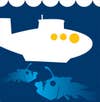Five Labs That Make Going to Class the Best Part of College
Not every student falls asleep at the thought of doing another lab. For a fortunate few, homework means setting off bombs, making lightning, crashing cars, and unleashing 100mph winds. Come meet the luckiest students in the country inside (with video)
Wanna be an aquanaut? How ’bout an alien hunter? A sports stat guru? Disease detective? Launch the slideshow to learn what the prereqs are for the greatest jobs in science.
1. Blow Up . . . Everything
Where: New Mexico Tech Energetic Materials Research and Testing Center (EMRTC)
What You’ll Learn: Why car bombs are so destructive; how to make diamonds
Future Job: Structural engineer, chemical engineer, explosives expert
Prospective Employers: Los Alamos National Lab, Department of Homeland Security
Today’s assignment: Create a five-pound car bomb and detonate it in a sedan. Tomorrow, shoot munitions across a half-mile canyon to see what you can hit on the other side.
EMRTC’s home is 40 square miles of uninhabited desert wilderness so remote that dozens of explosives tests-or “shots”-can take place in one day. Founded in the wake of World War II, EMRTC, one of the country’s foremost lab for explosives research, has everything from training grounds for mine-sniffing robots to areas where students blow up cars, tanks and buildings. Typical labs include packing several thousand pounds of ammonium nitrate around a container of carbon to manufacture industrial diamonds, or examining the safety of structures and substances that may be exposed to explosions in the real world. Students work on every aspect of the research, including setting up shots, analyzing data, and conceiving new tests.
2. Make Your Own Hurricane
Where: Wind Science and Engineering Research Center (WiSE) at Texas Tech University
What You’ll Learn: How to build structures that can withstand extreme winds
Future Job: Structural engineer, insurance consulting engineer, atmospheric scientist
Prospective Employers: National Hurricane Center, Global Energy Concepts, Risk Management Solutions
Today’s assignment: Simulate hurricane-force winds to hurl two-by-fours at shelter walls. Observe how easily they rip through the structures.
In addition to launching projectiles, students in WiSE’s Debris Impact Testing Lab throw themselves into the middle of real hurricanes and tornados. Before Katrina hit, students from Texas Tech were on the scene, setting up a mobile research center to take dozens of measurements, including wind velocity and the intensity of the storm’s eye. Their instruments were the only ones to survive the storm intact, and now the WiSE possesses the only complete record of the intensity of Katrina’s eye at landfall.
Based on the lab testing, and forays into disaster scenes during and after storms, the center was also responsible for today’s more accurate F-scale for measuring the force of tornados, called the Enhanced F-Scale. It reflects the finding that lower-speed winds do a lot more damage than previously believed. When students aren’t steeped in destruction, they’re figuring out how to make wind power more efficient or designing homes that will hold up better in the next Katrina.
Crash Cars
Where: George Washington University FHWA/NHTSA National Crash Analysis Center (NCAC)
What You’ll Learn: How to make a Civic survive a head-on crash with a Hummer
Future Job: Safety engineer, civil engineer
Prospective Employers: U.S. Department of Transportation, major auto manufacturers
Today’s assignment: Send a Ford truck careening into a 4,400-pound concrete pylon.
At the NCAC, every student in the school’s transportation-safety graduate program gets a car-and instructions to tear it down to piles of nuts and bolts, struts and glass sheets. Then the student rebuilds the vehicle in a computer model so he can virtually crash it again and again. (Students also help with real crash tests.) The lab works with auto manufacturers and the Department of Transportation to inform safety standards for cars and “roadside furniture,” such as light poles, barriers and signs. The current curriculum confronts a recent problem on the freeways: the huge population of SUVs, minivans and other small trucks. Students are trying to figure out whether objects like highway barriers should be changed to reflect the size of the vehicles likely to be plowing into them in the future.
Call Lightning from the Heavens
Where: University of Florida Lightning Research Lab
What You’ll Learn: That lightning can and will strike the same place many times
Future Job: Building lightning-resistant objects, from cell towers to helicopters
Prospective Employers: Motorola, Sikorsky, Raytheon, Kennedy Space Center
Today’s assignment: Catch lightning. Seriously. We’re talking millions of volts, shooting straight from a mass of black clouds down to a metal structure 50 yards away from where you’re taking notes.
At the Lightning Lab, a group of students and researchers work around the clock all summer to trigger lightning during passing storms. A thin wire attached to a rocket acts as a kind of fuse, coaxing a bolt of lightning down the so-called plasma channel to the grounded metal launcher. There the lab’s sensor networks help solve such mysteries as the cause of each stroke’s unique electromagnetic field, or how a direct hit will affect underground cables. But triggering lightning is not as easy as it sounds. Lab co-director Vladimir Rakov says the students are lucky if they get 40 strokes of lightning per season, and many of those could happen during the same storm. Five years ago, students in the Lightning Lab helped make one of the decade’s biggest discoveries: that most lightning emits x-rays. Today, students are still trying to figure out why by building new x-ray-sensor networks.
Play With Lava
Where: U.S. Geological Survey Hawaiian Volcano Observatory
What You’ll Learn: How to tread lightly around active volcanos; when to run
Future Job: Geologist, geophysicist, geo-information systems engineer
Prospective Employers: USGS, NASA, Google Maps
Today’s assignment: Take a hike on Kilauea Volcano, where 2,100F magma is spewing out of an 820-foot-wide crater. Tomorrow, measure exactly how far the lava flow has spread and how much poisonous sulfur dioxide is in the air.
As many as 20 students compete for each volunteer position working and living on one of the world’s most active volcanos. Up to eight students at a time sleep in a house in a national park and wake up before the crack of dawn to hike into the wilderness, mapping a region that might soon begin oozing molten rock. The payoff: helping elite researchers measure some extremely powerful underground action, including the bulging shapes created by underground magma flow and the seismic activity that spurs eruptions. Says scientist-in-charge Jim Kauahikaua, “For many, it’s their first experience with volcano work, and it changes their lives.”
Wanna be an aquanaut? How ’bout an alien hunter or a sports stat guru? Launch the slideshow to learn what the prereqs are for the greatest jobs in science.

So You Wanna Be A… Flavor Scientist?
-Bachelor’s or Ph.D. in food science, or related chemistry degree
-Food-company internship
-Fearless taste buds

So You Wanna Be An… Alien Hunter
-Bachelor’s and Ph.D. in chemistry, geology or microbiology, and advanced work in astrobiology
-Gift for navigating bureaucracy
-Stellar patience for long searches

So You Wanna Be A… Hurricane Diver
-Bachelor’s in meteorology. Oceanography, geology or climatology degree helpful
-Tolerance of turbulence (or Dramamine)
![Give your team a fighting chance with moneyball mathematics Among what he calls the various "inter-locking dramas" of baseball, Bill James looks for things to quantify. The godfather of "sabermetrics" joined the Red Sox organization in 2003, implementing stats like "range factor" ([assists + put outs] x 9/[defensive innings]) that helped Boston spot overlooked players and win its first World Series championship since 1918. How can you get the job? James, who learned stats from baseball cards as a kid, recommends knowing baseball history, studying the sport objectively, and publishing original research. "My view of the world, whether baseball or physics, is that there are oceans of ignorance and small ponds of knowledge." Is there room for another stat freak in baseball's ocean? Absolutely, James says: "We don't know nothin'." -Jeremy Hsu ** PREREQS:**<br />
-Skepticism about the status quo<br />
-A fan's mania<br />
-The ability to put fan mania aside](https://www.popsci.com/uploads/2019/03/18/ETFYS2EIUC23EZWRPMZNMCEDFE.jpg?auto=webp&optimize=high&width=100)
So You Wanna Be A… Sports Stat Guru
-Skepticism about the status quo
-A fan’s mania
-The ability to put fan mania aside

So You Wanna Be A… Disease Detective
-M.D. or Ph.D. (veterinarians and dentists needed as well)
-Language skills preferable
-Strong stomach a plus

So You Wanna Be A… Humanoid Roboticist
Bachelor’s, master’s and/or Ph.D. in engineering, computer science or cognitive sciences
Gift for mimicry

So You Wanna Be An… Aquanaut
-Bachelor’s in engineering
-Facility with electrical systems
-No claustrophobia